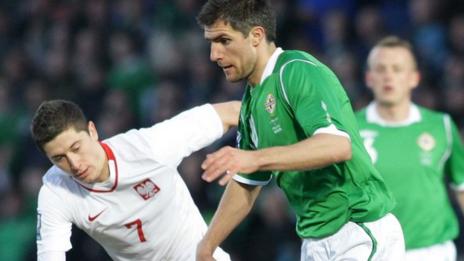By: Anthony Chammah
The UEFA European Championship, or Euro Cup, is held every four years and is a competition to determine which senior men’s national team is the most dominate. The Euro Cup first debuted in 1960, holding a finals competition among the top 24 teams out of the total 54 eligible to compete. Germany and Spain boast the most Euro Cup Championships with three each. This coming June, The European Cup will take place in France and the 24 qualifying countries will be divided into six brackets.
In this blog I will be examining the accuracy of first round matches in the 2016 Euro Cup. I will conduct this analysis by randomly selecting four first round matchups and simulating these matches on the Xbox One. I will record the statistics that each match produces and take detailed notes regarding interplay nuances from passing style to momentum shifts. The matches that will be analyzed are: France vs. Romania, England vs. Russia, Northern Ireland vs. Poland and Italy vs. Belgium.

The first match analyzed was France versus Romania. This was not a particularly exciting match to watch as Romania took the lead in overtime to win the match 1-0. In regulation both teams played very defensively and it was not until overtime that the rate of play drastically increased as well did the number of shots. In regulation there was a total of four shots taken by France and two shots taken by Romania. In over time each team took two more shots, but the only shot on goal the entire match was taken by Romania—this proved to be the deciding factor. While the Romanians did not take as many shots as their opponent, their midfield looked much sounder than that of France. They possessed the ball for 60% of the match and this was visible through their long passes and very technical style of play in the simulation.

England versus Russia, the second game simulated, proved to be a very exciting match to watch. Both teams demonstrated extremely aggressive attack styles, yet neither team was able to find the back of the net. In the first half, the Russians utilized very short passes, while longer and more elegant passes were employed by the English. At the half it would have been impossible to predict the winner. After half time, however, England dominated the first 5 minutes of play, scoring the first goal of the match. This did not create the momentum shift it would have in real life, though; the Russian offense retaliated with a long possession filled with great crosses, technical moves, and three shots, none of which were able to tie the game. The most promising Russian opportunity came in the 85th minute when their star striker missed a break away goal after receiving a chip pass from the midfield. The overall statistics of the game were extremely even, but also accurately depict what was seen during the match. England had a total of 6 shots, only one of which was on goal and was the only goal of the match. Russia, on the other hand, had 5 shots, 2 of which were on goal and none of which found the net. The similarities in shot statistics can be further exemplified by both teams’ time-on-attack. While one might assume the Russians spent more time on attack due to their dominance in the second half, the English actually spent 51% of the match with the ball in their possession.

One of the most exciting first halves of all the matches that took place was between Northern Ireland and Poland. Poland completely dominated this match, yet the possession percentage would not support my claim. Ireland maintained control of the ball for 55% percent of the game, though could not manage a single shot on goal. Poland managed to have four shots on target, scoring on one of them. Poland started the match well by using the entire field. They maintained a steady rate of passes which made it almost impossible for Ireland to get the ball out of their side of the field. Finally, in the 45th minute, Poland scored. Poland’s offense used quick passes within the box to find an opening and with a few jukes they were able to locate the net. After halftime the Polish no longer dominated the game flow. Ireland maintained possession for a large portion of the half but the Polish defense would not allow the Irish strikers to get even remotely close enough to the goal to attempt a shot. The tight Polish defense led to an extremely dull second half with the only ball movement being at midfield. Poland ultimately won the match 1-0 due to their exciting goal in the first half.

The most exciting simulation was undoubtedly between Italy and Belgium. Belgium began the game in extreme attack mode, nearly embarrassing the Italians. While the Italian squad held majority possession of the ball in the first half, they still struggled to build momentum. It was not until the injury of Lakaku, one of the Belgium forwards, that Italy started to create opportunities. After suffering an injury, the Dutch started utilizing their midfield to generate more chances. Toward the end of the first half, neither team was dominating the other; the Belgium midfield was generating opportunities but unable to capitalize, and the Italians could not break through their opponents defense in order to have a quality shot on goal. The second half started just how the first ended, with the Italians struggling to break past the Belgium defense. In the 58th minute the Belgium defense was able to stop the Italians, send the ball up the field to their forwards and ultimately score off of a rebound. While it was not a visually exciting or skillful goal, it provided them the lead. The momentum shift the Dutch received from their goal did not last long, though, as the Italians started dominating their opponent’s side of the field soon after. In the 76th minute, Italy saw its first goal on a long cross to a header. The game would stay tied until the end of the regulation. Overtime was not very eventful, as the ball went back and forth as each team tried to take the lead. It was not until the second half of overtime that Italy scored on a fast break, giving them both the lead and the victory. The statistics behind the matchup are extremely even; both squads had five shots, of which two were on goal. Italy only held possession of the ball for 47% of the match and still was able to pull away with the victory. While there is no way of empirically proving this statement, the loss of Lakaku could have been the reason why the Dutch lost the game, since they were forced to alter their traditional attack style and rely more heavily upon their midfield.

It is widely disputed as to how accurately the FIFA video game resembles real life. In the four matches I simulated and studied there seems to be an overarching pattern: real soccer demonstrates that statistics do not provide an accurate representation of the match. For instance, professional analysis of the 2016 Euro Cup predicts that France has an 82% chance of winning their bracket while Romania only has a 5.9% chance. Even though France is a much better and more stable team, anything can happen during a live match. The simulated game debunks the professional statistical prediction for the overall bracket winner. This can further be demonstrated in the other matches I simulated such as England vs. Russia. The unpredictability of soccer in real life can be seen throughout the FIFA video game. The amount of independent variables that could sway the outcome of the game makes it impossible to predict a winner. While Italy was favored in their Belgium matchup, if the Dutch starting striker, Lakaku was not injured he may have been able to lead their team to the victory. The outcome of the video game matches I simulated could predict the winners of each game and possibly how each team will play against their opponent. The mathematics behind the video game attempt to create realistic matchups, but ultimately time will tell as to whether or not these simulated first round matches play out as the video game predicted.

To the critics who question whether the FIFA video game is a fair representation of real life soccer: each year the game improves—whether it is an improvement in the graphical scenery, more realistic-looking players, or even the individuals styles of play. FIFA 15 made many changes to individual style of play. For instance, if one were to look at Lionel Messi, he consistently taps the ball lightly with his left foot just as he does in real life. It is these changes that make the game much more accurate. Each team in the FIFA video game is ranked based upon the skill level and performance of each individual player in real life. Each player is given an over all ranking based upon six soccer skill sets: Pace, Shooting, Passing, Dribbling, Defense and Physical. One of the best players in the FIFA game is Cristiano Ronaldo. His individual rankings are: PAC-93, SHO-93, PAS-81, DRI-91, DEF-32 and PHY-79. The average of these attributes is 92, making that his player ranking which is the highest in the game. The video game produces an average player ranking for each player in the game and the team ranking is dependent upon the average of all player rankings on that team. FIFA has also developed a way of increasing a team’s rating based upon their performance in past games. For example, if a team was playing in multiple matches in a season and performing extremely well, their ranking may increase. This attribute is not effective in the case study I performed, since each match was held individually, rather than in a tournament. This further evidences that the FIFA video game simulation of the Euro Cup first round matches may not be entirely accurate. This is because the qualifying matches that took place earlier in the year—which would impact the teams’ respective rankings—were not incorporated into the study. It can be said that the FIFA matches that I simulated provide a relatively accurate prediction of what may come in the tournament, but since certain variables could not be incorporated it is impossible to forecast what the verdicts of the games will truly be.
